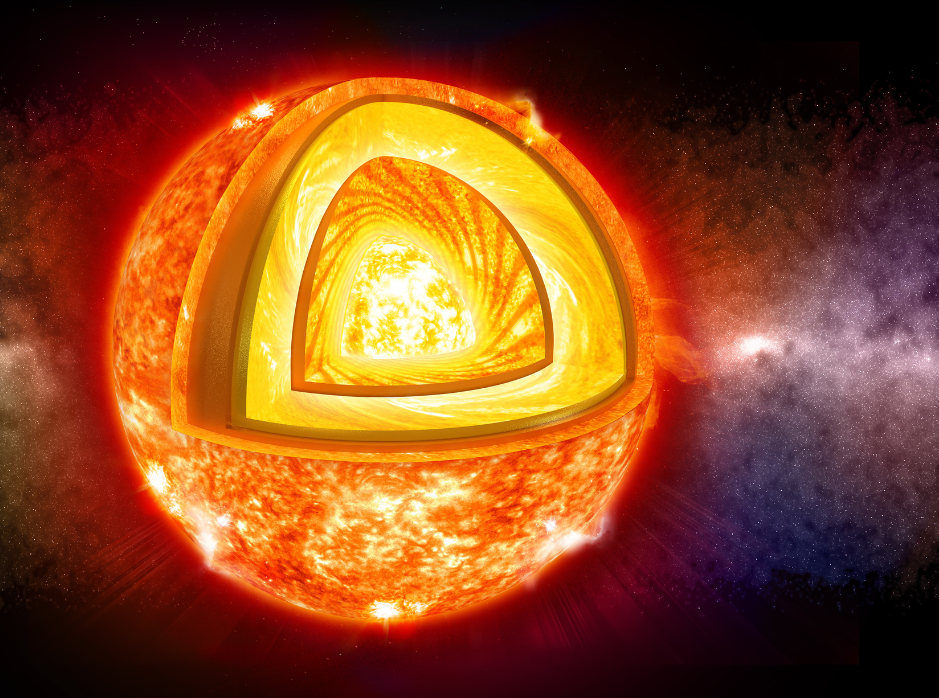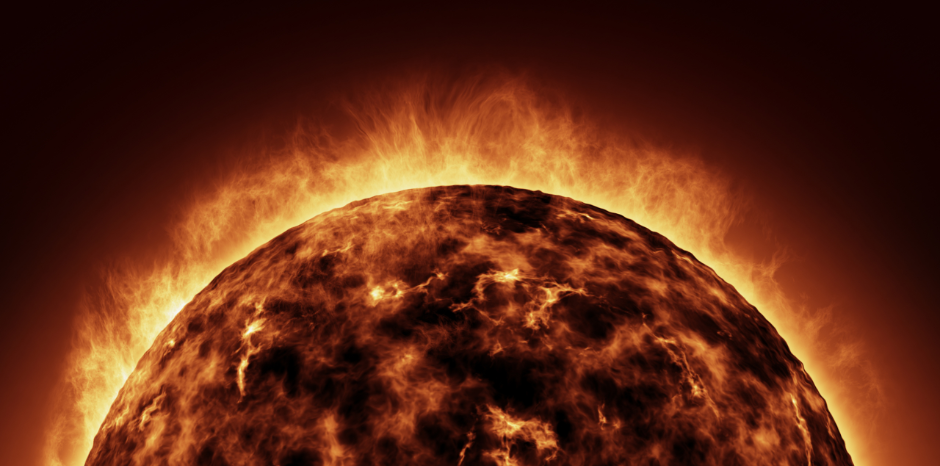What Is The Sun?

The Sun is a Main-Sequence G-type Star and formed around 4.6 billion years ago. Stars like this form when the centre mass grows so hot and dense that nuclear fusion begins in its core. This mechanism is assumed to be responsible for the formation of nearly all stars.
The Sun is composed of several layers. First, the atmosphere, which itself is broken down into several layers, from the outer heliosphere, corona and chromosphere. Then the photosphere, or visible surface. Below the surface we have the convective and radiative zone, which is where energy is transferred from the core to the outer layers. Finally, the Sun’s core, which is extremely hot and is the source of 99% of the Sun’s fusion energy.

How Hot Is The Sun? – The Sun’s Layers From The Middle Out
To answer the question how hot is the Sun, in short, it depends on which layer you are talking about. So to answer the question fully, we need to look at each layer respectively.
The Core
- Nucluer Fusion Occurs when Hydrogen fuses to create Helium
- Area is around 20-25% of the Sun’s Radius
- Approximately 86,000 miles / 138,000 km thick
- Temperature reaches around 15-15.7 million Kelvin / °C (27-28 million °F)
- The Density of the core is around 150 times that of water on Earth – 150 g/cm.
The Core is the engine room of the Sun. It is where fusion takes place as Hydrogen atoms fuse to form Helium. Under great pressure this creates immense power and heat, with temperatures reaching upward of 15 million degrees Kelvin in the core.
This immense energy radiates outward and upward towards the Radiative Zone.
The Radiative Zone
- Energy is transferred here from the Sun’s core via the process of thermal radiation.
- The radiative zone is the thickest area of the Sun.
- Photons take upward of 170,000 years to find their way through this zone from the core out toward the convective zone.
- Temperatures drop in this zone as the density of ions drops from the are closes to the core, outward to the convective zone.
- In the area of the radiative zone closest to the core, temperatures can be around 7 million °C, dropping to 4 million °C at the outer edge of the zone.
The radiative zone is the largest area of the Sun. It is the first layer outside the core and heat is transferred via thermal radiation rather than convection in this zone.
This thermal radiation is the result of photons emitted from helium and hydrogen ions, traveling a short distance before being reabsorbed by other ions.
Temperatures are lower than in the core – between 4-7 million °C cooling the further out from the core.
Convective Zone
- Convective currents take over the job of transferring the sun’s energy outward toward the surface.
- This is because the photon density is too low to allow for thermal radiation in this zone.
- Instead, convective currents generate, (think of boiling water) allowing for pockets or bubbles of hot plasma to transfer the sun’s energy to the photosphere.
- Temperatures in this zone drop to around 2 million °C .
- This convective zone is about 120,000 miles wide.
The plasma density is too low in the convection zone to continue thermal radiation, transferring heat energy outward. Instead, the lower density of photons allows for the creation of convection currents.
This abrupt change in rotation style takes place in an area called the Tachocline where it is theorised that the Sun’s magnetic field is created.
It is the convection currents in this zone that are responsible for the granular appearance on the Sun’s surface.
Photosphere
- This is the layer we consider to be the Sun’s surface.
- It is the deepest layer from which we can observe visible light.
- The temperature drop off in this layer is huge, with temperatures reaching around 5,500 °C / 10,000 °F
- The Photosphere is where we can see sunspots on the surface.
- Sunspots are cooler areas of the surface with temperatures as low as 3,000 to 4,500 °C / 5,400 to 8,100 °F.
- Sunspots appear as dark spots on the surface.
- This layer is approximately 250 miles thick, with a particle density of ~1023 m−3.
From Earth, the Photosphere appears to be the surface of the Sun, but it is actually the first layer of the Sun’s atmosphere. As the atmosphere above the Photosphere is transparent, photons leave this layer in what we perceive as visible sunlight.
Cooler areas called sunspots can appear in the Photosphere from time to time, and these can be seen with solar imagery as little black spots.
The particle density in this layer is around the equivalent to a third the density of Earth’s atmosphere at sea level.
Chromosphere
- This is the layer of atmosphere between the Photosphere and the Corona.
- The Chromosphere ranges in temperature from approximately 6,000 °C nearest the Photosphere, to approximately 4,000 °C in the temperature minimum region extending around 200km – 500 km from the Photosphere.
- This is the coolest place in the Sun’s atmosphere with the exception of some Sun Spots.
- As altitude is gained in the Chromosphere, temperatures rise up to around 20,000 °C
- Now, beyond this area the is a thin layer where the Chromosphere starts to heat up rapidly.
- Some refer to this area as the transition zone.
- Temperatures here rise from 20,000 °C up to 1,000,000 °C as helium becomes fully ionised.
The next layer of the Sun’s atmosphere is the Chromosphere and there are some interesting properties in this layer.
The temperature in the Chromosphere drop off to around 4,000 °C in the temp minimum area, before starting to climb gradually as altitude is gained. Between the temperature minimum area and the transition zone, the Chromosphere will gradually increase in temperature to around 20,000 Kelvin.
In the top region of the Chromosphere, Helium becomes partially ionised. But as you move into the thin transition zone, the Helium becomes fully ionised and temperatures rise dramatically.
Corona
- The Corona is the outer layer of the Sun’s atmosphere.
- Temperatures in the Corona are hotter that any other layer of the Sun’s atmosphere.
- In fact, temperatures in the Corona can reach levels only otherwise reached in the Core.
- It is still a mystery why the temperature in the Corona is dramatically higher than the layers that precede it.
- Temperatures in the Corona range between 1,000,000 °C – 2,000,000 °C / 1,800,000 °F – 3,000,000 °F on average, but can reach much higher than that.
- Coronal Mass Ejections could be catastrophic to electronics and satellites.
The Corona is the outermost layer of the Sun’s atmosphere. We can only really see the Corona during an eclipse, when the sun is covered and a glow is seen around the edges of the eclipse.
Temperatures in the Corona average between 1 million °C – 2 million °C but in hot spots can reach up towards a terrifying 8 – 20 million °C.
A flow of plasma that leaves the Corona out toward the extremities of the Heliosphere, is know as the Solar Wind. Occasionally this plasma is ejected from the Corona with some magnetic field in large expulsions know as Coronal Mass Ejection.

Sun Mysteries Still Unsolved
While there are plenty of theories, the extreme temperatures in the Corona remain an unsolved mystery. The fact that this layer is magnitudes hotter than the levels of atmosphere that precede it has experts baffled. Imagine lighting a campfire, then walking away from that fire only to find that you get warmer when you are further away.
Observing The Sun
You should never observe the Sun with the naked eye. Doing so can cause permanent and life changing damage. There are specialist solar lenses you can get for telescopes and binoculars, and techniques that allow for indirect viewing. There are also specialist glasses you can get for viewing solar eclipses. I can not stress enough the importance of using these devices properly to maintain good eye health and promote happy viewing.